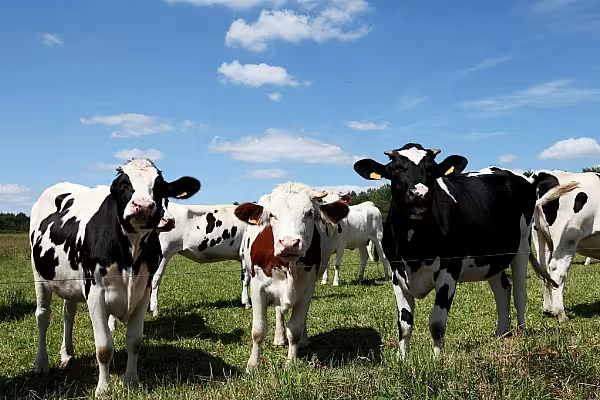Dairy farmers Bryce and Amanda Savage begin work before 5 a.m. and rarely finish before 6 at night. They even keep a round-the-clock vigil some evenings in case cows have difficulty calving. What’s worse, the 7-day-a-week job is pushing the New Zealand couple deeper into debt.
The Savages are so-called sharemilkers, part of a long tradition in New Zealand where typically landless farmers provide labor, and often their own cows, to an established farm in exchange for use of the pasture and equipment, as well as a cut of the milk check. The arrangement is the backbone of one of the world’s most efficient dairying nations, but after a two-year slide in milk prices, it’s in crisis. The Savages have had to let a farmhand go, sell 60 cows and borrow more money just to get by.
The couple bought a farm in 2013 and were counting on the cash flow from sharemilking to give them enough equity to move onto the property after three years.
“We’re basically having to start again,” Bryce, 33, said at the kitchen table, looking out at the farm in South Taranaki, a dairying region of the North Island, that he’s been working on since 2007. “It’s a bit of a kick in the guts.”
Prices Fall
Global dairy prices have fallen by more than half from early 2014 levels, causing milk processors to slash payments to farmers, about 80 percent of which are operating at a loss in New Zealand, according to the central bank. Sharemilkers, who account for more than a third of the nation’s milk suppliers, are bearing the brunt of the impact because, unlike farm owners, they typically miss out on the extra dividends and loans paid by dairy cooperatives.
Average operating profit for sharemilkers who own their herds was less than half that of farm owners in the three years to 2015, according to a report from AgFirst, a rural consultants’ network in New Zealand, published in May. Sixty percent of sharemilkers said they had cut down on the amount of money they were withdrawing from their businesses amid the downturn, versus 39 percent of farm owners, the report showed.
“It’s really unfortunate that the young people -- the sharemilkers, the future of our industry -- are the ones who are really taking the biggest hits,” said Ross Dunlop, mayor of South Taranaki and a farmer himself. “That’s a worry, that those people will leave the industry and be hard to replace.”
Own Herds
One in six New Zealand farms in the year ended May 31 were run by sharemilkers who owned their own herds -- typically the final step before farm ownership. That was down from 23 percent in 2004-2005, according to the AgFirst report.
The number of sharemilkers intending to buy their own dairy farm dropped to 47 percent, from 70 percent 10 years ago, AgFirst said. A separate survey from Federated Farmers indicated a fifth of sharemilkers felt they were getting “undue pressure” from banks regarding their overdraft, versus 10 percent for other dairy farmers.
Neil Bateup hears some of the consequences of that. The dairy farmer chairs a rural support service that runs a 24-hour hotline catering to a dairying district more than 300 kilometers (186 miles) north of Taranaki.
Typically, three or four calls are taken each month, but their frequency doubled last year, mostly driven by distressed sharemilkers seeking advice about mental health, financial and relationship difficulties. It’s now up to about 20 to 25 per month, Bateup said.
‘Under Pressure’
“It just reflects the fact that people are under pressure,” he said. “The good thing is that people are calling us and we can help facilitate a way forward.”
Problem loans will increase “significantly” with many farmers facing a third season of negative cash flow, the central bank said in May in a report on potential risks to the stability of the New Zealand economy. Lending is concentrated, with 10 percent of the country’s farmers holding 30 percent of the total debt, according to Citigroup Inc.
South Taranaki Mayor Dunlop has sharemilkers working his own family farm, about 11 kilometers from the Savages. The system provides a way for older farmers to ease their workload while giving young milkers the cash and experience to start out on their own.
‘See it Through’
“I know that they’re struggling,” Dunlop, 61, said. “But they’re still pretty confident that they want to see it through because they’ve been through the good times.”
Fonterra Cooperative Group Ltd., the nation’s dominant milk processor and the world’s top dairy exporter, is seeing “early signs” of a recovery in prices, Chairman John Wilson said in a statement Thursday.
Even still, prices for whole milk powder are unlikely to return to the peak levels above $5,000 a ton reached in 2013, said Hayley Moynihan, Rabobank Groep’s general manager in New Zealand. A drop in Chinese imports along with the lifting of decades-old quotas on European dairy production and sanctions restricting access to the Russian market are weighing on prices.
“It’s not a good time to exit as you’re not going to get your money out,” said Bryce Savage. “You’ve just got to keep farming through it.”
News by Bloomberg, edited by ESM. To subscribe to ESM: The European Supermarket Magazine, click here.














